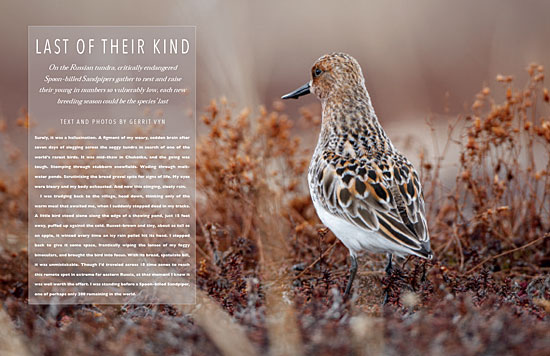General Discussion
Related: Editorials & Other Articles, Issue Forums, Alliance Forums, Region ForumsLast of Their Kind (Intimate Glimpses of One of the Most Endangered Birds on Earth)
http://www.allaboutbirds.org/page.aspx?pid=2577

Text and photos by Gerrit Vyn
Surely, it was a hallucination. A figment of my weary, sodden brain after seven days of slogging across the soggy tundra in search of one of the world’s rarest birds. It was mid-thaw in Chukotka, and the going was tough. Stomping through stubborn snowfields. Wading through melt-water ponds. Scrutinizing the broad gravel spits for signs of life. My eyes were bleary and my body exhausted. And now this stinging, sleety rain.
I was trudging back to the village, head down, thinking only of the warm meal that awaited me, when I suddenly stopped dead in my tracks. A little bird stood alone along the edge of a thawing pond, just 15 feet away, puffed up against the cold. Russet-brown and tiny, about as tall as an apple, it winced every time an icy rain pellet hit its head. I stepped back to give it some space, frantically wiping the lenses of my foggy binoculars, and brought the bird into focus. With its broad, spatulate bill, it was unmistakable.
Though I’d traveled across 18 time zones to reach this remote spot in extreme far eastern Russia, at that moment I knew it was well worth the effort. I was standing before a Spoon-billed Sandpiper, one of perhaps only 200 remaining in the world.
I had come on an assignment from the Cornell Lab of Ornithology to record the first high-definition video footage ever taken of Spoon-billed Sandpipers on their breeding grounds, as well as to take photographs and high-quality sound recordings for the Lab’s Macaulay Library. I spent nearly every day of June and July 2011 on the Siberian tundra searching for spoon-bills and documenting every phase of their breeding cycle I witnessed. I was with a 10-person expedition crew, made up of ornithologists and conservationists, there to monitor and work to save this critically endangered species.
FULL story at link.
MynameisBlarney
(2,979 posts)And if those ain't the cutest baby boids EVAR, I'll eat my hat.
Solly Mack
(90,773 posts)Manifestor_of_Light
(21,046 posts)Or a dodo bird?
Wednesdays
(17,380 posts)Because even after conservation efforts to save the pigeon were in force they continued to die off. The last few in captivity refused to mate. The theory is that passenger pigeons would mate only if they were among huge numbers of their species.
Love Cornell Lab!
msedano
(731 posts)Thinking of the last one of the last 200 makes me incredibly sad. The novel, Last of the Curlews, about the final one of its species, evokes similar sadness.
Dustlawyer
(10,495 posts)It made me cry and started me off as a conservationist.
Curmudgeoness
(18,219 posts)from my young days, but I thought it was called The Last Albatross. I cannot find it anywhere, and I have searched the internet. Maybe it wasn't an albatross.
I also became an environmentalist because of that movie, among other things. It was the saddest thing I can imagine. ![]()
Plucketeer
(12,882 posts)I currently share my home with four parrots - each a different species. Two of these species are threatened in their natural habitat. One is fading because they were (and proably still are) captured for the pet trade. The other is fairly rare in captivity (tho ours was bred here in the USA) and their natural habitat is all but COMPLETELY gone - and disappearing fast. Examples of these two species ARE being bred in captivity and that gives these two hope of some sort for the future. But for what KIND of future??? The one's eroding habitat will NEVER be restored to where it could support reintroduction if such a plan were devised. While the birds can survive in captivity - the nuggets of knowledge that parents taught offspring about survival in their natural habitat are lost to time completely. These parrots I have - all bred in captivity - they have a zero chance of surviving if they were turned loose in the wilds.
I hate to think of the extinction of these birds, and polar bears, and rhinos and so on and so forth. But is that any more rational than lamenting the passing of the massive arrays of species that came and went even before we climbed down out of trees? Evolution, extinction and the dawning of species we may never live to see - this is how this planet works, and has worked for billions of years. We humans think that because we can perceive of the world around us - WE are responsible for it - its "curators" if you will. Heck, I've got a 50 year old car I restored some years ago. I'll bet it's not preserved til 2100 AD. We can not stop everything just as we like it. We just can't.
DreamGypsy
(2,252 posts)There are links to other videos on Spoon-billed Sandpiper foraging, courtship, and breeding here. Worth watching.
The intricacies and subtleties of species behavior ... as individuals develop, survive, court, breed, care for the next generation, flourish, and ...die... is always astounding.
Thanks to researchers and conservationist like Gert Vyn whose works are constant reminders of the wonders we share in the world and how much we have to lose. And, thanks to Omaha Steve for the post.
graywarrior
(59,440 posts)ellenfl
(8,660 posts)postulater
(5,075 posts)1-Old-Man
(2,667 posts)polly7
(20,582 posts)And adorable.
Omaha Steve
(99,660 posts)I'm pleasantly surprised.